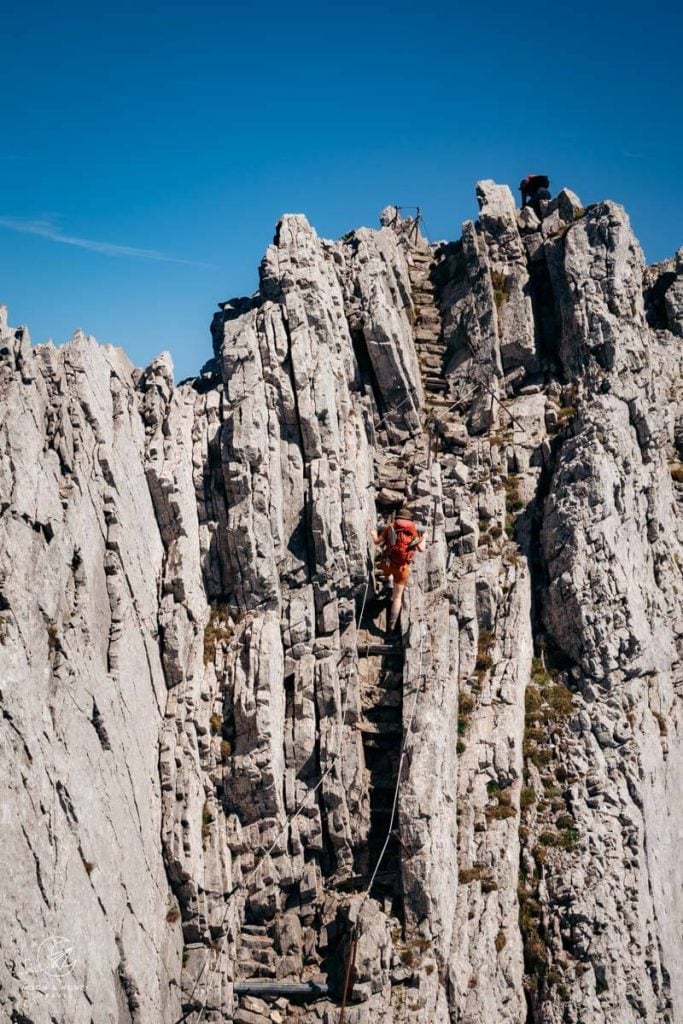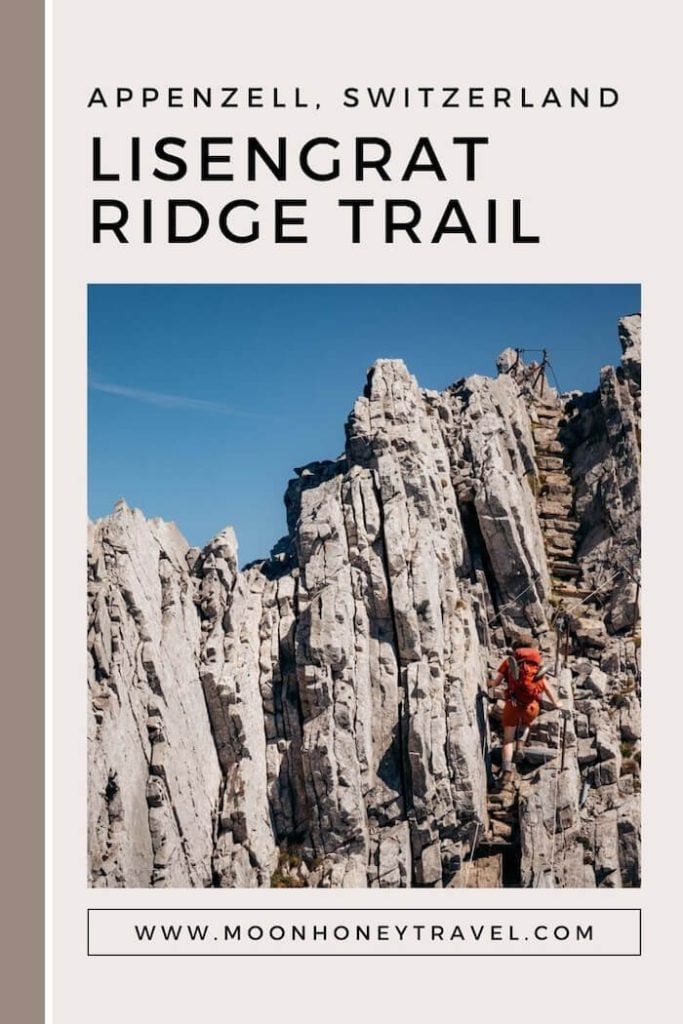Lisengrat is the mountain ridge that links Mount Säntis (2502 m) to Mount Altmann (2435 m) in the Alpstein massif in the Appenzell Alps of Switzerland. The ridge runs perpendicular to the main mountain chains of the Alpstein.
Mount Säntis and Mount Altmann are the highest and third-highest peaks in the Appenzell Alps respectively.
The Lisengrat ridge hike refers to the stretch of trail between Mount Säntis and the Rotsteinpass mountain pass, which was built in 1905 and restored in 2010.
It’s a heavily secured alpine path that is bolstered with fixed cables and platform steps. Along the way, hikers must navigate narrow ledges, steep rock staircases, and slippery scree descents.
This adventurous ridge trail is suitable for surefooted hikers who have a head for heights.
Most hikers start the Lisengrat hike atop Mount Säntis, which is accessible by cable car from Schwägalp. However, many others hike to Lisengrat trail as part of a longer, multi-day hike like this 3-day Alpstein High Trail.
From the Rotstein mountain pass, it is possible to extend the hike to Fliswand wall and even all the way up to the summit of Mount Atmann.
There are several places to eat along the trail, including Berggasthaus Rotsteinpass and Berggasthaus Alter Säntis.

- Starting Point: Säntis-Schwebebahn Cable Car Valley Station | Google Maps
- Trailhead: Säntis Cable Car Mountain Station
- Distance: 5.1 km out-and-back
- Time Needed: 2:30 hours
- Elevation Gain/Loss: 400 meters
- Difficulty: Moderate (Moderately Difficult)
- Minimum Elevation: 2122 meters
- Maximum Elevation: 2501 meters
- Where to Stay near Schwägalp: Säntis – das Hotel (luxury) or Säntisecho (budget)
- Where to Stay in Appenzell Village: Alte Metzg – Hostel (budget), Blattenheimat (midrange), Hotel B&B Stossplatz (midrange), or Hotel Appenzell (luxury)
- Recommended Trail Map: K+F 09, Appenzell, Säntis, St. Gallen 1:40.000
Lisengrat Ridge Trail Hiking Map
Lisengrat Ridge Trail Difficulty

The Lisengrat ridge trail is a white-red-white mountain hiking trail, which signifies “moderate,” or “medium” difficulty. The difficulty lies in the rugged terrain, narrow ledges, and the high-alpine character of the trail.
Though the trail is exposed, all exposed areas are secured with fixed cables. When navigating airy sections, there is always something to grab onto. In other words, there’s no total exposure.
Weather conditions will impact the difficulty of the Lisengrat ridge trail. For that reason, we only recommend hiking this path in dry, snow-free conditions.
This out-and-back hike only takes 2:30 hours total. Allow extra time for breaks and lunch in the Rotsteinpass Hut.
Where to Start the Lisengrat Hike
Schwägalp Pass / Mount Säntis Cable Car Mountain Station

The Lisengrat trail starts at the summit of Säntis, the highest mountain in the Alpstein.
To reach Mount Säntis, head to Schwägalp pass and take the Säntis-Schwebebahn cable car up to the summit.
Schwägalp pass is accessible by car, or by transit. Use sbb.ch to search for transit connections.
During the hiking season (June – late October), the Säntis-Schwebebahn cable car runs every 30 minutes between 7:30 am and 6 pm. On weekends, the cableway runs until 6:30 pm.
Säntis Cable Car Pricing | See up-to-date pricing on saentisbahn.ch. Swiss Half Fare Card and Swiss travel Pass holders receive a 50% deduction.
Säntis Cable Car Valley Station Location | Google Maps
Lisengrat Ridge Hiking Trail Description
Mount Säntis Summit to Berggasthaus Alter Säntis (5 minutes)

The entire summit of Mount Säntis is built-up with viewing platforms, a transmission tower (radio/TV), restaurant, an interactive adventure world, and mountain inn.
Before starting the hike, walk up to the summit viewing platform. The summit affords excellent views of all the Alpstein range. You can see Mount Schäfler, Hoher Kasten, Lake Seealpsee, and many more recognizable landmarks.
Looking southeast, Altmann is the bicolored mountain towering above Rotsteinpass. You can even spot Berggasthaus Rotsteinpass, clinging to the pass.
There are two hiking trails that start at Mount Säntis. The Heaven’s Ladder (Himmelsleiter) descends the northern flank of Mount Säntis.
The Lisengrat Ridge Trail starts at Berggasthaus Alter Säntis, the mountain hut that’s situated just below the Säntis summit.
There’s a path that connects the terrace of Alter Säntis to the starting point of the Lisengrat trail.
Berggasthaus Alter Säntis to the Lisengrat Trailhead (5 minutes)

From the terrace, hike down the cement stairs. Cross the rocky slope and follow the cabled-secured ledge beneath the covered walkway.
Directly ahead, you’ll see the Churfürsten (Churfirsten) limestone chain, the southernmost range of the Appenzell Alps.
The Lisengrat trail starts out dramatically. The trail is chiseled into the rocky spine of the ridge and flanked by cables. The path is reinforced with metal platform steps.
Lisengrat Trailhead to Rotsteinpass (1 hour)

Climb up the steep stairs. The trail wraps around a ledge and then crosses the wide, grassy ridge of Chalbersäntis.
The path, marked with white-red-white poles, is initially quite rugged, but quickly smooths out.

Below to your left, you can see Meglisalp mountain pasture beneath Marwees.
Ignore the trail that branches off to the right in the direction of Schafboden-Unterwasser.
The path gently descends, often maneuvering around massive limestone outcrops and walls.

Keep your eyes out for ibex.
The Lisengrat trail continues along an impressive ledge carved into the Wisswand wall.

A short, cabled-secured ascent brings you to the top of the ridge, where a formidable-looking staircase plummets and rises before you.
After descending the cable-secured staircase, the trail makes a steep counter-ascent. When you get to the top of the chiseled stairs, you’ll see the Rotsteinpass mountain inn once again. The refuge is backed by the Fliswand mountain wall.

If you look back, there’s also a great vista of the jagged ridge stretching out to Säntis.
The Lisengrat trail descends more steeply now. Use the cables to safely twist down the crumbling path, scattered with scree.

Hiking poles are extremely helpful for this section. These Unisex Black Diamond Hiking Poles have been our loyal hiking companions for years.
With time, the path eases and crosses the grassy slopes of Lisengrat to reach the Rotsteinpass hut (2122 m).
Enjoy lunch in this lovely hut, before starting the return journey.
Rotsetinpass to Mount Säntis (1:35 hours)

Follow the same trail back to Mount Säntis.
Optional: Summit Mount Altmann

From Rotsteinpass, it’s possible to extend the hike to Mount Altmann (55 minutes one-way). The way to Mount Altmann follows a white-blue-white trail. It takes 30 minutes to crest the Fliswand Pkt (2334 m) along a heavily-secured path. From the Fliswand junction, it’s a 25-minute hike to the summit of Altmann.
We hiked to Fliswand Pkt on our way to the Zwinglipasshütte SAC (stage 2 of the Alpstein High Trail). We skipped Altmann, because we were already exhausted, having started the day at Mount Schäfler.
If you end up hiking to Mount Altmann, leave a comment below and tell us about it.
Where to Stay in Appenzellerland
Schwägalp
Luxury | Säntis – das Hotel is located next to the Säntis-Schwebebahn cable car at Schwägalp Pass. This modern and sleek hotel offers 68 comfortable rooms and suites, a wellness spa (3 saunas and a whirlpool), and a restaurant.
Budget | Säntisecho – in der Natur zu Hause is a guesthouse with several 2-bedroom apartments. This budget-friendly accommodation is only a 3-minute drive to the Säntis-Schwebebahn cable car valley station.
Appenzell Village

The lovely town of Appenzell is the capital of the Swiss Canton of Appenzell Innerrhoden. Surrounded by beautiful countryside, Appenzell is a picturesque town with colorful gabled buildings that house delicious bakeries, restaurants, hotels, apartments, and museums.
Accommodations are always clean and comfortable, but modest. There are no 5-star hotels in this area of Switzerland.
We recommend staying in, or near the village center of Appenzell, because of the dining options and cultural activities (museums and art galleries). After long hikes in the Alpstein, it’s ever so nice to end your day in the heart of Appenzellerland.
Appenzell is also a great base for those traveling without a car. With train connections to Wasserauen and Weissbad (bus transfer to Brüllisau), it’s effortless to get around to various trailheads.
Budget | Alte Metzg – Hostel offers 3 spotless rooms with communal bathrooms and kitchen facilities. This intimate hostel is walking distance to the Appenzell village center and train station. On-site parking is available, but must be reserved in advance (fees apply). They also run the neighboring midrange Alte Metzg Boutique Pension with private single, double, and family rooms.
Midrange | Blattenheimat – im traditionellen Appenzeller Haus (2 nights minimum stay) is a traditional, gabled house with 2-3 bedroom apartments and free private parking, very close to the Hauptgasse (pedestrain main street of Appenzell). Guests have access to a washing machine and dryer in the basement.
Midrange | Located very close to the Appenzell train station, Hotel B&B Stossplatz is a darling bed and breakfast with free private parking, free bikes, and a shared lounge. Rooms either have shared, or private bathrooms.
Luxury | Hotel Appenzell is located on the historic Landgemeinde Square in the center of Appenzell village. Boasting an excellent restaurant with an outdoor terrace as well as a confiserie (patisserie), this traditional Appenzell hotel is a great option for your stay. Breakfast and parking are included in the rate.
Luxury | Adler Hotel is centrally located at the start of the pedestrian Hauptgasse (main street), across from the Parish Church of St. Mauritius and the Metzibrücke Bridge. This traditional hotel with two restaurants is a great place to stay if you’re traveling without a car. No parking available on-site.
Look for accommodation in Appenzell.
Weissbad Village
Weissbad is a quiet village in Schwendetal Valley between Appenzell and Wasserauen.
Situated on the Gossau–Wasserauen train line of the Appenzell Railways, Weissbad is a great base for exploring the region. It takes a mere 6 minutes to reach Appenzell village by train.
It takes only 10 minutes to ride the train to Wasserauen (Ebenalp cable car valley station, Seealpsee trailhead, Marwees trailhead, etc…). And, it’s only an 8-minute bus ride to Brüllisau (Hoher Kasten cable car, Saxer Lücke and Fählensee trailhead).
Midrange | Weissbad Lodge, not to be confused with the nearby sister property of Hotel Hof Weissbad (luxury), is a comfortable accommodation with spacious, modern rooms and free on-site parking. The lodge is located on the bank of the Sitter River, just a block away from the Weissbad train station and bus stop. The only negative is the self-service breakfast.
Luxury | Hotel Hof Weissbad accommodates luxury-minded travelers with its two restaurants and bar, two swimming pools, fitness center, spa and wellness area. Breakfast and parking are included in the room rate. The price is rather steep.
Look for accommodation in Weissbad.
Schwende Village
Schwende lies in Schwendetal Valley, just south of Weissbad.
This village is also located along the Gossau–Wasserauen train line, with direct connections to Wasserauen, Weissbad, and Appenzell.
Midrange | The family-run Hotel Frohe Aussicht, which means “happy outlook,” is a hillside hotel and restaurant surrounded by beautiful countryside. It’s a short uphill walk from the Schwende train station to the hotel. Guests love the views and the restaurant!!!
Keep Reading about Appenzell
Travel Guides:
Hiking Guides:
- Best Hikes in Appenzell
- Schäfler Ridge Trail
- Hoher Kasten – Saxer Lücke Hike
- Berggasthaus Aescher: Cliff Restaurant
- Marwees Ridge Trail
- Lake Seealpsee
Trekking Guides:
Self-Guided Hut-to-Hut Hiking Tours:
- Swiss Whiskey Trek
- 8-Day Hut to Hut in Appenzell Alps Standard Itinerary
- 6-Day Hut to Hut in Appenzell Alps Active Itinerary
- 6-Day Easy Appenzell Alps Relaxed Itinerary
Alps Trip Planning Essentials
When to Visit the Alps
We recommend visiting the Alps in summer (June – mid September), fall (mid September – late October) or winter (late December – March).
Read Alps in Summer to learn everything you need to know about visiting the Alps between June and mid/late September.
Alps Road Trips
Most destinations in the Alps are accessible by transit. If you’re visiting during peak seasons, we recommend traveling with trains and buses.
If you’re visiting during shoulder seasons (late May, early June, late September, October), a car is often essential in getting around.
When we go on hut-to-hut hikes, we always travel with transit. When we want to do a lot of day hikes, we find it easier to travel with a car.
We recommend using the Discovercars.com car rental reservation platform to search for and book car rentals. This easy-to-use booking platform compares car rental deals from 500+ trusted providers, so that you can choose the best option for your trip.
Alps Road Trip Itineraries
- Italian Alps: 5 Day Dolomites Road Trip
- Italian Alps: 7 Day Dolomites Road Trip
- Italian Alps: 10-14 Day Dolomites Road Trip
- Bavarian Alps and Tyrolean Alps: 10-Day Bavaria and Tyrol Road Trip
- Austrian Alps: 2-Week Austria Road Trip
- Austrian Alps: 1 Week Austria Road Trip
- Slovenian Alps: 2-Week Slovenia Road Trip
- Slovenian Alps: 5-Day Slovenia Road Trip
Alps Hiking Guides
Hiking in the Alps is our passion.
To learn about when to hike, where to hike, and hiking safety, read: Hiking in the Alps: Essential Tips. For trail inspiration, check out Best Hikes in the Alps.
For region specific trail inspiration, read:
- Bavarian Alps: Best Hikes in Garmisch-Partenkirchen
- Italian Alps: Best Day Hikes in the Dolomites
- Austrian Alps: Best Day Hikes in Austria
- Slovenian Alps: Best Hikes in Slovenia
Alps Hiking Essentials
- Day Pack: Osprey Tempest 30 Women’s Backpack / Osprey Talon 33 Men’s Backpack
- Grade B/C high-cut hiking boots: Meindl Schuhe Island Lady (Kati’s Boots), Women’s Hanwag Tatra II GTX (Sabrina’s Boots), Men’s Hanwag Tatra II GTX (men’s equivalent)
- CAT 4 Sunglasses: Julbo Shield Mountain Sunglasses
- Hiking Poles: Black Diamond Trail Trekking Poles
- Backpack Camera Clip: Peak Design Camera Clip

Pin this Image for Future Trip Planning!
Stay Connected:
Connect with us on Pinterest.
Follow us on Instagram.
Like us on Facebook.
Support Us:
If you love reading our content, you can buy us a coffee via Ko-Fi.



